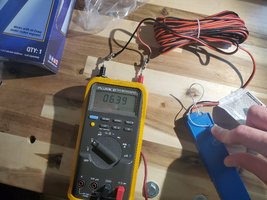Mesatchornug
NES Member
Ok, @Picton and @safetyfirst2125, consider me nerd-sniped. I'm going to try to do this entire project without any traditional firearm materials (e.g., powder, projectiles, etc.). In fact, everything should be had from your friendly neighborhood hobby shop, home improvement store, or online retailer.View attachment 636026
This is how @andrew1220 ends up with two DEagles, and I end up with an electronic front stuffer...
What follows is FOR EDUCATIONAL PURPOSES ONLY
Since we already agreed that I probably won't be the first to a Proof of Concept, y'all can follow me on the path to a "Product-Improved" version. I'm no @Boris, so expect different cursing. In today's episode, we collect some core components and our intrepid MechE fumbles with a couple electrons.
First, we have some model rocket bits and bobs. The remote is giant, so that's the first thing we'll have to replace...after we test our first barrel, on a bench, from 30 feet (~9 m for anybody following along in Canaderp).

Step 1 - characterize the igniter circuit.
Looking inside the remote, we are reminded the batteries are in series. Series = add. Expect about 6V. Dang, I was hoping I could get away with a 1.5V 18650 LiPo - I'm sure we'll test it and a 9V anyways... (maybe with a giant capacitor or two)

Confirm assumptions. Despite my particular preference for problems I can directly poke and prod, I do own a DMM for diving deep with the pesky pixies. A little bit of coaxing and we see 6.39V. Maybe that class in college wasn't completely wasted.

Now, how much current are we looking at? If photographing with my left hand while holding both buttons on the remote with my right wasn't hard enough, timing it to catch max draw on the solar igniter wasn't going to happen. Sure, I could have used video - screw that. Here, we see 2911 mA. You'll have to trust me that it got up somewhere between 3500 and 4000 mA. Since it's obviously already glowing, let's call 3.5A sufficient clearance.

Ok. I smell like I've been letting out the magic smoke. For once, that's even on purpose. But what have we learned? The reference circuit draws [nominally] 6Vdc @ 3.5A, pumping 21W into the solar igniter with a resistance of 1.7Ω. That's no slouch.
Next time, we'll explore what it takes for reliable ignition when installed through the touchhole.
Last edited:

![Wave [wave] [wave]](/xen/styles/default/xenforo/smilies.vb/011.gif) In!
In!